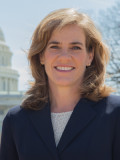
 By General Counsel K. Hollyn Hollman
By General Counsel K. Hollyn Hollman
During my tenure at the BJC, I have had the privilege to learn from and collaborate with some of the country’s brightest church-state scholars. Among those I admire and who have provided valuable assistance to the BJC in our efforts to promote religious liberty are Ira C. “Chip” Lupu and Robert W. Tuttle of The George Washington University Law School.
In addition to inspiring passion for religious liberty among their countless students, Lupu and Tuttle have published on a wide variety of church-state issues and influenced a number of significant policy debates. They are among the very best church-state specialists when it comes to explaining complex ideas with clarity.
In Secular Government, Religious People, they present a theoretical framework for understanding religious liberty that unifies much of their earlier work and provides a valuable new resource for lawyers, teachers and students of religious liberty. Their book is a clearly written overview of the religious liberty landscape through a lens that offers a convincing approach for understanding the Founders’ vision and protecting religious liberty today. While it is not an introductory work for a novice, it is accessible to attorneys and non-attorneys interested in the subject matter. One helpful contribution to the scholarship is its respectful challenge to some widely held ideas about certain aspects of religious liberty law, such as the government’s role in providing religious exemptions. They provide explanations of cases and competing views among the justices to support their thesis and to illustrate other threads in religious liberty law, while respectfully pointing out differences of opinions within the scholarly community.
The title aptly describes the fundamental aspect of religious liberty at the heart of the book. The U.S. Constitution provides for a secular government that protects religious liberty by separating government and religion. Indeed, a good way to understand the separation of church and state is simply to recognize the character of civil government and its limited jurisdiction.
As historic Baptists are well aware, the Founders’ experience involved establishments of religion that declared and enforced orthodox beliefs, imposed taxes to support churches and compelled attendance at worship. Lupu and Tuttle explain that nonestablishment marks a radical break with religion, withdrawing religion from the jurisdiction of civil government. “Under the nonestablishment principle, the government does not promote religious worship, oversee religious indoctrination, or exercise religious authority. Instead that responsibility belongs solely to the people and their voluntary religious communities.” Those who seek a robust role for religion in society, however, should not be discouraged by this arrangement since “the government [is not signaling] hostility to religion … [but] recognition of its own boundary … fully consistent with respect for activities that lie outside that boundary.”
In chapters addressing church autonomy, government funding of religion, religious expression in the public schools and other topics, the authors explore and explain how this constitutional limit on government creates space within which religious individuals and institutions can flourish. They assert that the core of religious liberty — freedom of and from worship, individually and in assembly with others; the right to disseminate a religious message and seek to persuade others; the right of religious groups to be treated equally with others under the law — is primarily a product of the space created by nonestablishment norms. Lupu and Tuttle put it this way: “The Free Exercise Clause is about the free character of the people’s faith. The Establishment Clause is about the limited character of the government created by those people.”
The authors demonstrate that this nonestablishment principle runs throughout our constitutional history and case law. They assert it is a far better framework for protecting religious liberty than one that relies on competing claims between those who want to be free from government-supported religion and those who want government to reflect the religious views of the majority. Instead of being based on a theory of rights, they explain nonestablishment as a structural barrier that keeps government out of religion. While a secular government can respond to its religious people, it has no jurisdiction to advance or align itself with religion.
Though the BJC may differ with the authors in some matters, particularly with regard to whether and to what extent government may or must provide religious exemptions, we embrace the value of the central idea that “religion constitutes a jurisdictional limit on civil government.” We applaud this contribution to church-state scholarship and appreciate its potential to create continued respect for and protection of religious liberty.
From the January 2015 Report From the Capital. Click here to read the next article.




